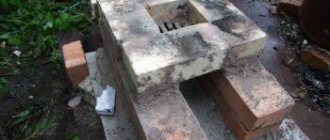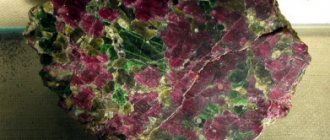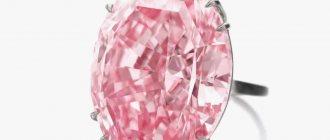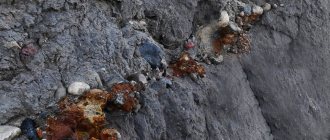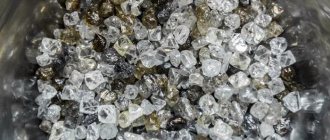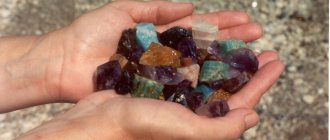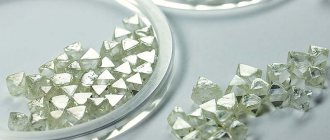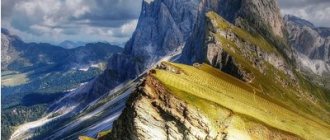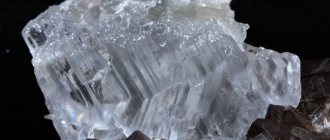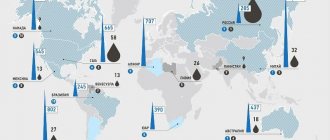Basalt is a decorative rock formed as a result of the eruption of volcanic lava onto the ground surface. In the process of movement, the lava captured other rocks and minerals - plagioclases, pyroxenes, calcites. After solidification, stones with a porous structure of all shades of gray, black and black with a greenish tint were formed.
Basalt is rightly called the stone of the Universe. Its deposits have been discovered not only on Earth, but also on other planets - Mars, Moon, Venus. The stone has high strength and aesthetic characteristics, due to which it is actively used in construction, decoration, cladding and other industries.
History of basalt
Basalt bracelet
The history of this rock goes back millions of years. The strength characteristics of basalt were appreciated in ancient centuries; in those days it was already used for the construction of dwellings and the manufacture of household items. The chronicles of Pliny the Elder mention that basalt was first discovered in Ethiopia.
Translated from Greek, “basalt” (basanos) means “touchstone”. In Ethiopian, basal means “iron-containing, boiling stone.”
Reasons for processing basalt
It was natural to think about fusing this rock, since it itself is of fiery origin. But it is not enough to melt: with rapid cooling, castings from it give a glassy mass, similar to natural hyalobasalts, fragile and technically not everywhere.
The main task of petrurgy (stone foundry industry) is the restoration of the crystalline structure in a cast product - regeneration. The idea of the possibility of remelting and restoring rocks to their original form arose in the 18th century. The Scot James Gall achieved remelting already in 1801 and, in particular, established that basalt and lavas, when molten and quickly cooled, produce glass, while when cooled slowly they produce a rocky mass with a crystalline structure.
In 1866 Dobre and then in 1878 F. Fouquet and Michel Levy reproduced many rocks of fiery origin and found that this did not require either extraordinary or mysterious mineralizing agents; it's all a matter of establishing the proper melting and annealing conditions.
After cooling, the molten silicate mass turns into glass, the temperature of which is lower than the temperature of the original rock. To restore the crystalline structure, it is necessary to anneal the glass mass at a temperature higher than the softened vitreous body, but below the melting temperature. The temperature interval between these points is the region in which regeneration of silicate or aluminosilicate is possible; there may be this gap. and insignificant
Physicochemical characteristics
According to its chemical composition, basalt is an oxide of silicon, calcium and aluminum. The largest share (up to 53%) is silica. In small proportions the composition contains alkalis of sodium and potassium, oxides of magnesium, iron, manganese and phosphorus.
Basic physical properties of basalt:
| Index | Description |
| Mohs hardness | 5-7 units |
| Density | 2530-2970 kg/m² |
| Transparency | Opaque |
| Shine | Absent |
| Melting temperature | 1100-1400°С |
| Acid and alkali resistance | Stable |
| Porosity coefficient | 0,6-19% |
| Water absorption coefficient | 0,15-10,2% |
Other properties of basalt include the environmental friendliness of the rock, frost resistance, wear resistance, heat and sound insulation.
Basalt columns near Basaltove, Ukraine
Cobalt crystal lattice detail
| 500 | Crystal cell | |
| 511 | Crystal grid #1 | α-cobalt |
| 512 | Lattice structure | Hexagonal close-packed |
| 513 | Lattice parameters | a = 2.505 Å, c = 4.089 Å |
| 514 | c/a ratio | 1,632 |
| 515 | Debye temperature | 385 K |
| 516 | Name of space symmetry group | P63/mmc |
| 517 | Symmetry space group number | 194 |
| 521 | Crystal grid #2 | β-cobalt |
| 522 | Lattice structure | Cubic face centered |
| 523 | Lattice parameters | 3.537 Å |
| 524 | c/a ratio | |
| 525 | Debye temperature | |
| 526 | Name of space symmetry group | |
| 527 | Symmetry space group number |
Place of Birth
Basalt
The origin of basalts is igneous. Its deposits are formed in places where volcanic lava flows, both on the surface soils of mountain ranges and on the bottom of the oceans. The length of the layers on land is up to 30 km. The plates that lie on the ocean floor are smaller in size. Their length usually does not exceed 6 km.
On an industrial scale, basalt is mined in Russia - Altai, Transbaikalia, Khabarovsk Territory and Kamchatka.
Deposits of this rock are also found in India, China, Ethiopia, Ukraine, Uzbekistan, Armenia and Brazil. In Italy, the adjacent territories of the volcanoes Etna and Vesuvius are rich in stone deposits. Basalt is mined in Scotland, Iceland and Ireland.
Basalt is mined by open-pit mining - by grinding out massive blocks and layers in quarries.
How they are mined: quarries
We have already briefly talked about how basalt is mined. If it’s for crushed stone, then the easiest way, of course, is to blow it up. I drilled a hole, planted explosives, and then it fell apart on its own, all that was left was to pick it up. Further on to the stone crusher, sorting and into cars to the final consumer.
But it happens that you need something else, for example, to cut a block, which will then be cut into slabs. Previously, we believed that this was only relevant for plutonic and hypabyssal analogues of basalt, but here is a video that shows that basalt is also cut out in blocks.
All this happens in open basalt quarries. Other methods of extraction are irrelevant in relation to it.
Varieties
Basalt is divided into varieties depending on its origin, scope of application, chemical composition and color.
By origin there is a breed that is formed:
- on the bottom of the oceans in the depths of mid-ocean plates;
- in the soils of island arcs and the vicinity of active volcanoes.
Pillow basalts on the seabed of the South Pacific Ocean
According to the structure of the crystal lattice, basalt can be:
- lime;
- glandular;
- alkaline-lime;
- ferrobasalt.
Based on their chemical composition, the following varieties are distinguished:
- quartz-standard – with a predominance of silica in the composition;
- hypersthene-normative – with low content of quartz and nepheline;
- nepheline-standard – with low silica content.
The characteristic columnar structure of basalt
According to its decorative qualities, basalt can be:
- Basaltite is the most expensive type of basalt mined in Italy. In terms of strength, this stone is on the same level as granite. It is used as a facing material in the interior and exterior.
- Twilight basalt is a durable and weather-resistant stone with shades ranging from gray to black. Black basalt is used for exterior and interior decoration. The only supplier of raw materials is China.
- Asian basalt - a dark gray variety used for cladding indoors and outdoors, is inexpensive.
- Moorish basalt - dark green stones with randomly located inclusions of different colors, are valued in decorative arts. It is used only for finishing and decorating interiors, as it has low strength and is not resistant to low temperatures.
According to the mineral composition, sedimentary rock basalt is graphite, apatite, plagioclase, labradorite, anorthite, nepheline, leucite and melilite.
Use of basalt building materials
The most common building material is crushed stone. It is laid at the base of highways and railway tracks, poured as a cushion under foundations and under sand bedding when laying pipelines. Small fractions are part of concrete and are used when filling dirt paths and constructing paths and platforms from figured tiles.
Basalt is a non-porous stone and does not absorb moisture, so it is not afraid of frost - tiles and products do not burst in the cold. Thin polished slabs are used to make cladding for facades, cladding of fountains, sculptures, and small architectural forms. From massive stones - curbs (curbs), steps, floor tiles, paving stones. The durability of paving and cladding made of basalt slabs is also facilitated by the high elasticity of the stone.
One of the modern trends in the production of building materials is the production of composite products. Basalt fibers in combination with polymers are used to produce basalt plastic reinforcement (BRP). In many operational characteristics, ABP is not inferior to steel, but is resistant to corrosion. Now they have begun to use continuous fiber for the production of reinforcement - it gives the structure greater strength, elasticity and flexibility, which expands the scope of use of composite reinforcement (for example, in earthquake-resistant structures).
Application
Basalt sink
The areas of application of basalt are very numerous:
- Thermal insulation materials - mineral wool, heat-insulating mats, felt - are intended for insulation of chimneys, roofs and walls of buildings.
- Electrical insulation – stone is used in linear insulation of metro and railways. Basalt insulators are used in the construction of telephone and telegraph networks.
- Basalt chips – used as an anti-corrosion coating and filler for concrete. Raw materials are also used in the manufacture of sandwich panels and cleaning filters.
- Facing material - decorative and paving slabs, stairs, fences, columns, arches, fountains, sculptures are made from rock. Basalt tiles are used to cover the external and internal walls of buildings, floors, bathrooms, swimming pools, baths and saunas. The mineral is used for making tombstones and finishing crypts.
- Construction - basalt pillars and reinforcement are used in the construction of multi-story buildings, when laying the foundation.
- Decorative art - stone carvers love basalt for its plasticity. A large number of products are turned from the mineral - from small souvenirs to furniture elements.
- Jewelry making - basalt is used to make jewelry. Beads, pendants, pendants and bracelets are framed in copper or jewelry alloy, and, at the request of the customer, in gold or silver.
Basalt products
Yakut basalt: deliberate failure or inept management
YKTIMES.RU – The Arbitration Court of Yakutia issued a ruling declaring TBM LLC insolvent. On November 24, a monitoring procedure for a period of 4 months was introduced in relation to the company headed by people's deputy Yegor Zhirkov. YakutiaMedia news agency tried to figure out why the enterprise, which had great economic hopes, and in which about a billion rubles had been invested, turned out to be practically bankrupt.
The innovative project “Basalt - New Technologies”, implemented in Yakutia, began in May 2010, when an agreement was signed between the Republic of Sakha (Yakutia) and RUSNANO. Its cost at that time was 950 million rubles. Investors at an early stage were the Republican Investment Company (RIK OJSC), Bank of Moscow OJSC (under the program of the Russian Development Bank “Financing for Innovation and Modernization”), at the end of 2011 the project was invested by the federal development institutions RUSNANO and SME Bank".
The opening of a plant for the production of composite materials based on basalt continuous fiber took place on July 24, 2012. On this day, the official launch ceremony of the first stage of high-tech production took place. The priority direction of production has become the production of composite reinforcement, since it is in great demand in the region. It was planned to produce at least 2,260 tons of continuous basalt fiber, 2,600 tons of basalt-plastic reinforcement, and up to 32 thousand cubic meters of basalt concrete structures and products per year.
– The first hundreds of meters of basalt-plastic reinforcement with a diameter of 12 millimeters were produced on one production line and eight millimeters on another. This is the most popular and necessary type of basalt-plastic composites, which is used in construction and industry. The fittings are needed for the manufacture of pipelines, supports, piles, and road surfaces,” said the head of the enterprise, Egor Zhirkov, then.
That's all. After the pompous opening, industrial production never began. As Zhirkov himself admitted, the production volume of continuous basalt fiber at the enterprise has always been “tiny.” He explained that the reinforcement was used at ALROSA enterprises; it was used to strengthen shafts and stowage chambers along which technological transport moves. Indeed, in 2012, by agreement with AK ALROSA, basalt-plastic reinforcement was used in concreting a section of the surface filling complex of the materials storage department of the Mir mine, but the “composite reinforcement” was not put into commercial use. At the same time, there were attempts to “roll” the technology into city road networks, but according to the director of TBM LLC himself, only about 100 meters of reinforced asphalt were laid. Well, the construction business showed no interest due to the high cost.
The economics of the project were extremely simple. The innovative material was supposed to replace obsolete and expensive steel reinforcement. “In the Urals, a ton of steel reinforcement costs 28 thousand rubles. The average price in Yakutsk, including delivery, is 45 thousand rubles per ton. One ton of basalt reinforcement, as confirmed by the Research Institute of Iron and Reinforced Concrete, can replace eight tons of steel reinforcement. The economy is like this: multiply 45 thousand by eight, it turns out 360 thousand rubles. While a ton of basalt-composite reinforcement will cost the buyer 240 thousand rubles. It turns out that the product we produce is competitive,” says Zhirkov.
So why didn’t the project take off? A year and a half later, auditors of RUSNANO and VEB structures considered the inactive project to be risky, and TBM LLC - not fulfilling the terms of the contracts. “Rusnano invested 400 million rubles, but withdrew after 2 years. The government decided that RIC would buy out Rusnano’s share, which is 150 million rubles. Now there is a debt to Rusnano of about 180 million rubles,” says Zhirkov.
“RIK”, which was bound by a guarantee agreement, entered the project involuntarily and had to compensate for the share of federal investors. At the same time, the company did not participate in the capital, but financed TBM LLC through loans. A year after these events, in mid-July 2015, RIC, interested in the financial performance of basalt projects, removed Egor Zhirkov from the post of director of Basalt Materials Plant LLC with the wording “ineffective management.”
“At the end of July 2015, taking into account the difficult financial situation, I suspended the production of continuous basalt fiber,” comments Egor Zhirkov on production that never began. No money left. Meanwhile, Yegor Zhirkov is the only deputy Il Tumen who did not submit a declaration and did not disclose information about his income. In addition, the VLSI system contains information that Zhirkov is a co-founder of UK TBM LLC and at least six other legal entities that are in one way or another connected with the activities of the basalt materials plant.
But the MP found funds for a trip to the United Arab Emirates. Basalt-composite reinforcement, presented at The Big 5 International Building & Construction Show in Dubai, won in the Innovation category and was awarded the Gaia Awards Grand Prix. It should be noted that the award is given to companies whose products demonstrate a reduction in the impact of construction on the environment. However, in comparison with the same steel reinforcement, in terms of environmental friendliness, the Yakut development does not stand out in any way. In addition to the high cost.
However, deputy Il Tumen preferred to take part in the Arab exhibition rather than in the regular plenary meeting of the State Assembly of the Republic, where the budget and other important issues were discussed. I did not consider it necessary to listen to the annual Address of the Head of Yakutia to the people's representatives. But following the trip, Yegor Zhirkov called a press conference, after which the journalists left with the feeling that the authorities did not understand the importance of the project. This is despite the fact that throughout last year the YakutiaMedia news agency wrote about the efforts of the government and individual ministries to include the “Basalt - New Technologies” project in TASEDs. Let us remind you that thanks to the persistence of the regional cabinet, the project was even included in the short list of the Ministry for the Development of the Far East, but was postponed because “there are no clear sales markets.”
And in general... an enterprise created with the maximum assistance of the state and unable to win its place in the market blames the state itself for all failures - seems quite strange. For example, the same company TechnoNIKOL, which produces basalt insulation similar to the Yakut one, knows how to competently use marketing mechanisms and get out of a crisis situation. Without any administrative or financial support.
And finally. The work biography and career breakthrough of Yegor Zhirkov is truly impressive. In 1976, he graduated from Yakut State University with a degree in Mathematics, in 1985 he received the academic degree of Candidate of Pedagogical Sciences, and in 1993 - Doctor of Pedagogical Sciences. Since 1997, he has held senior positions at large enterprises and government agencies.
In 2000, Zhirkov, who already had experience in the gold mining industry (FPC Sakha Gold), was appointed head of the city- and budget-forming enterprise of the Oymyakon region, CJSC Sarylakh-Surma, and later also OJSC Zvezda. The only financially stable mining enterprise in Russia, focused on the extraction and processing of antimony ore, began to suffer by the end of 2006. In 2007, 60% of the shares of both enterprises were sold for almost nothing to Poisk OJSC. And after a very short period of time, the Republican antimony industry was taken over by the GeoProMining company (GPM, GeoProMining), paying $6.5 million for a controlling stake.
Medicinal properties
Basalt is actively used in stone therapy. The crystals are heated to t=50°C and applied to biologically active points. When in contact with the skin, the heat from the stones penetrates to a body depth of up to 4 cm, providing a healing effect on the vital systems and human organs.
Lithotherapists recommend resorting to the power of basalt in the following cases:
- to strengthen the immune system;
- for psycho-emotional disorders – nervous overstrain, stress, depression;
- for the treatment of infertility in both women and men;
- to regulate the functioning of the thyroid gland;
- with inflammatory processes in joints, muscles, and skin;
- to restore metabolism.
Jewelry with basalt also has healing powers. They are worn near the sore spot.
Where is it used?
The areas of application of the breed are determined by physical and aesthetic parameters. What made it popular is its resistance to wear, fire, and fungus. Plus a reasonable price.
Jewelry
Jewelry belongs to the costume jewelry segment and is framed with jewelry alloy or copper. To order - silver or gold.
The mass assortment is not rich: bracelets, beads, pendants, pendants.
Basalt jewelry
The porosity of the structure makes them unusual. Large black stones look brutal, this is an attribute of the male segment.
Decor
The structure and properties of the rock made it a favorite of stone cutters. They turn everything from pyramids and boxes to tables, small chairs and other furniture. Its configuration can be the most intricate.
Other areas
Black basalt is in demand as a soil in aquariums and other artificial reservoirs.
He is endowed with magnetism. This helps to distinguish basalt from other dark stones and has a beneficial effect on the living creatures and vegetation of the reservoir.
Basalt fiber is made from basalt rocks by melting them and converting the melt into fibers.
Basalt fiber furniture
The most popular basalt products
Stone is known as a raw material for the production of insulating and finishing materials. Basalt insulation materials are distinguished by their heat resistance, vapor permeability, and physical stability. Mineral wool perfectly retains heat in a room. The presence of voids of varying sizes provides reliable thermal insulation.
The use of stone in the manufacture of chimneys for fireplaces or stoves is due to its high temperature resistance.
The material prevents heating of surrounding tissues, ensuring high safety of the structure.
Therefore, stone is actively used to insulate chimneys in bathhouses and rooms where temperature conditions play a significant role in safety.
Mineral tiles are used for facade or interior finishing work. It fits into any design, gives the interior a cozy and finished look.
The popularity of the stone is due to its environmental friendliness and safety. Affordable price and wear resistance make the material a favorite among analogues.
In addition, a video blog about the possible uses of the stone:
Magic of stone
Pendulum for dowsing made of balalt stone
The basalt rock has long been considered a talisman against dark forces and ill-wishers. It was placed in the house to protect the home from fires, disasters and accidents, and was taken with them on long journeys.
Basalt also has another purpose. It is used to attract good luck and find ways out of difficult situations. The stone promotes the development of the inner world, causes a craving for learning and the discovery of abilities. It gives peace of mind and peace, develops intuition, enlightens thoughts and motivates to work.
Appearance of the breed
The rock looks like a dark-colored stone (light-colored specimens are less common). In nature it is represented by columnar units in the form of pillars with 3-7 edges. The stones have a porous, dense massive or almond-like structure. In the latter case, the rock is called mandelstein, the tonsils of which can be filled with calcite, plagioclase and other substances. Depending on the type, basalt is painted in oily black, gray, smoky, greenish-gray shades (see photo). The presence of yellowish olivine phenocrysts is possible. The edges of the stone are uneven, the surface is rough.
Basalt and the signs of the Zodiac
Astrologers believe that basalt is not energetically suitable for all zodiac signs.
He favors representatives of the Fire element (Leo, Sagittarius and Aries), reducing their emotionality and bestowing prudence.
It is not recommended to use the stone for signs of the Earth elements (Capricorns, Virgos and Taurus). Contact with basalt can cause them to become withdrawn and psycho-emotional discomfort.
Representatives of the elements of Air (Libra, Aquarius, Gemini) and Water (Cancer, Scorpio, Pisces) can use basalt as an ornament or decorative item, relying on their feelings. If a stone causes depressing feelings or discomfort, then it should be removed.
Is basalt a mineral or not?
Let's start with a non-trivial question in the title. In fact, without reading further, what do you think: is basalt a mineral or not?
In this regard, we would like to joke somehow, but we will refrain, of course. The fact that the questioner is not sure is understandable. It is not clear why: is basalt useful or is it a fossil?
As for the benefits, it is enough to recall how much this stone does every winter when it prevents the warmth of our homes from dissipating in space.
As for fossils, there is also a clear “yes.” It is only necessary to clarify that building materials and raw materials for them are a separate category of “ non-metallic/non-metallic minerals ”, which does not include fossil fuels.
How to spot a fake
Basalt has an affordable price and a large number of offers, so it is not profitable to fake it. In terms of properties and appearance, untreated gray basalt is slightly similar to granite.
You can distinguish one rock from another by its structure - in basalt it is porous. Basalt heats up quickly and retains heat for a long time.
Column of basalt flows in Yellowstone National Park, USA
What building materials are made from basalt?
It is impossible to imagine modern construction without basalt materials. Here's a short list:
- crushed stone of different fractions;
- filler for concrete;
- reinforcing fibers and meshes for concrete and asphalt concrete, plastering works;
- paving stones;
- slabs for paving paths and platforms;
- facing slabs;
- sculptures, borders, etc.;
- cast stone containers;
- heat, sound insulation and fire retardant products (basalt wool, slabs, stitched mats, fabrics, cords, reinforcing mesh, cylinders and segments);
- structural sandwich panels and sandwich pipes;
- composite reinforcement.
How to wear and care?
Basalt is a versatile stone that can be worn by both women and men. The preferred age category is people over 30 years old. Products with stone fit harmoniously into a wardrobe of boho, folk and ethnic styles.
It is not recommended to wear accessories with basalt in business style and for evening events.
Rock basalt does not require any special care. It is not afraid of the sun, high humidity and temperature changes. It is enough to periodically clean it from dirt using products for cleaning natural stones.
What it is?
Basalt is an effusive igneous rock that belongs to the main composition of the normal alkalinity series of the basalt group. Translated from the Ethiopian language, “basalt” means “boiling stone” (“iron-containing”). From a chemical and mineralogical point of view, basalt has a complex structure. It contains intertwined crystalline formations and fine-grained suspensions of magnetite, silicates and metal oxides.
Volcanic rock appears as an interstratal body, found as a lava flow that occurs after a volcanic eruption. This is a stone of black, smoky black, dark gray, green-black hue. Depending on the variety, the structure may differ (it can be aphyric, porphyritic, glassy, cryptocrystalline). The mineral has a rough surface and uneven edges.
The bubbly structure of the material is explained by the release of vapors and gases during the cooling of the lava. The cavities in the erupted mass do not have time to close before it crystallizes. Various minerals (calcium, copper, prehnite, zeolite) are deposited in these holes. Basalt is easily distinguishable from other rocks. It is mined using the open-pit method - by grinding out blocks from quarries.
The interdependence of the properties of a given stone and its use
Any use of natural resources in human economic activity is associated with their properties. Basalt is no exception in this regard.
Basalt wool. Photo by Leroy Merlin
Once upon a time it served only as a building material. Then it found application in road construction. But basalt had competitors everywhere. But where he turned out to have no equal is in stone casting and the production of stone wool.
What properties is this based on? These are the chemical composition, the melting point, and the ability to form very thin and very long fibers during certain technological processes.
In fact, man didn’t even have to go through many options with different stones: as you know, the idea of basalt wool appeared after man’s comprehension of such a phenomenon as “Pele’s hair” - this is the formation of a natural analogue of stone wool, which is found wherever there is surface volcanic activity and strong winds.
Otherwise, we believe that it is quite obvious how other properties of basalt and the use of stone are connected; above we gave examples of such a connection.
